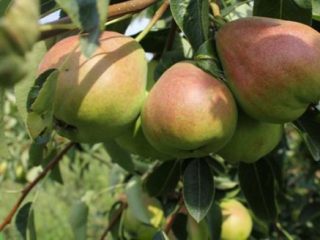Content
- 1 Climatic features of the region
- 2 Which pear variety to choose for the Urals
- 3 Summer pear varieties for the Urals
- 4 Autumn varieties of pears for the Urals
- 5 Winter pear varieties for the Urals
- 6 Delicious varieties of pears for the Urals
- 7 Self-fertile pear varieties for the Urals
- 8 Low-growing pear varieties for the Urals
- 9 Columnar pear varieties for the Urals
- 10 Conclusion
- 11 Reviews of pear varieties for the Urals
The best varieties of pears for the Urals are presented in a wide variety. To choose the appropriate type of fruit crop, you need to study popular options.
Climatic features of the region
Growing pears in the Urals is quite difficult, since the region has a very difficult climate that is unfavorable for most fruit crops. Winters in this part of the country are cold, with strong winds and little rainfall. Spring comes quite late, and night frosts can return even in summer.
Growing pears in the region is also complicated by the poor quality of the soil. In the Urals, the soils are mostly podzolic, rather poor, and often swampy. Fruit crops in such conditions require frequent feeding with complex minerals.
Which pear variety to choose for the Urals
It is better to plant a pear variety in the Urals with maximum resistance to adverse conditions. The tree must be frost-resistant and highly immune to fungal diseases.
Preference should be given to zoned varieties bred directly in the Urals. They usually tolerate difficult growing conditions quite easily and do not cause unnecessary problems for gardeners.
It must be taken into account that even the hardiest pear varieties are characterized by increased sensitivity at a young age. If the variety, as described, tolerates cold well and does not suffer from frosts of about -30 ° C, the tree still needs to be carefully insulated in the root area and along the crown for the first few years.
Summer pear varieties for the Urals
Summer varieties usually begin to bear fruit in mid-July and allow harvesting until the end of August. The shelf life of such pears is not very long, but the taste is sweet and fresh.
Big
A winter-hardy pear variety for the Urals produces large fruits weighing up to 150 g. The skin of the fruit is thin but dense, yellow with a reddish blush on the sunny side. The pulp is sweet in taste, dessert-like, without sour or tart notes. Ripe pears emit a pleasant fruity aroma.
The variety has good winter hardiness and easily tolerates the climate of the Urals. The trees bear fruit abundantly and regularly, regardless of the weather.

Large pear can withstand frosts down to -3 ° C during the flowering period without damage
Duchess
A dessert variety of English selection produces medium-sized or large elongated fruits. The peel of the fruit is golden, reddish on the sides, the pulp tastes like honey, with a wine tint.
Ripe Duchess pears are not suitable for long-term storage.But if you pick the fruits unripe, you can keep them in the refrigerator for up to a month.

The mass of Duchess fruit is about 150 g
Rainbow
The frost-resistant variety is well suited for breeding in the Urals. It is distinguished by stable fruiting and produces abundant harvests even in cold summers. Ripe fruits reach 140 g in weight and have a pleasant sweet taste.
The rainbow plant tolerates lack of light and low temperatures well and rarely suffers from bacterial burn. At the same time, scab and some insects, for example, the gall mite, pose a danger to the crop.

Rainbow pear is self-sterile and requires pollinators to be planted nearby
Autumn varieties of pears for the Urals
Autumn pears in the Urals usually ripen in September. The fruits are stored in the refrigerator for quite a long time, but it is important to collect them from the branches in time. Ripe fruits on the shoots begin to deteriorate within a week.
Fun
The variety of Belarusian selection bears wide and weighty fruits up to 130 g. The skin is yellow with a red blush, the flesh is sour-sweet, refreshing, and has a fine-grained structure.
Harvesting is necessary from mid to late September. Pears are suitable for long-term storage; they can last about a month and a half in the refrigerator. Fun in the Urals rarely suffers from fungi and common bacterial diseases.
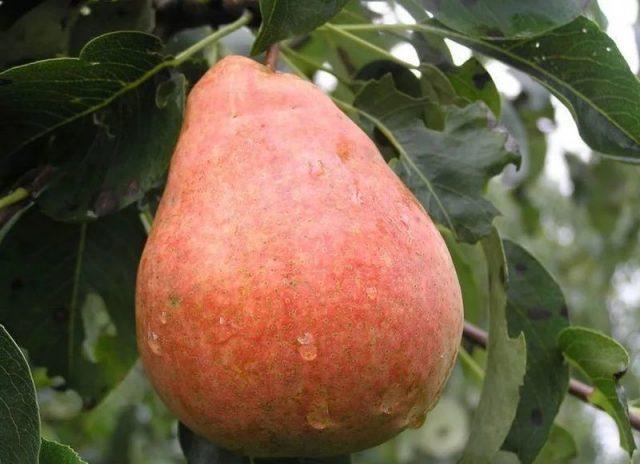
The fungus begins to bear fruit from the fifth year after planting
Autumn sweet
The pear takes root well in the conditions of the Urals and Siberia. Does not suffer from recurrent frosts, is not afraid of high humidity, and is rarely affected by scab. Ripening begins in late September or early October.
The fruits of the variety are bright yellow, large, with sweet and juicy pulp.The disadvantage of the pear is its self-sterility. To obtain a good harvest, it is necessary to plant pollinators with similar flowering periods next to the Autumn Sweet.

The average weight of the Autumn sweet pear is 80 g
Chusovaya
The popular Ural pear variety bears fruit in early September. The fruit is yellow with a greenish tint; the skin may have a pink blush. The fruits are medium in size, weighing up to 90 g. Their pulp is fine-grained, sweet, and of good juiciness. Sourness and astringency are completely absent even in unripe fruits.
The variety for the Urals has high immunity to diseases and pests. Rarely suffers from gall mite, which is especially dangerous for pear trees.

Chusovaya tolerates winter frosts well and requires minimal insulation
Winter pear varieties for the Urals
Winter pears usually ripen in early October. You can harvest throughout the month. But by the first frost, the fruits must be removed from the branches - if they freeze, the taste will noticeably deteriorate.
April
A winter-hardy pear variety for the Urals enters the fruiting period in its fourth year of life. Brings yellow-greenish fruits that ripen in late September or October. The fruits remain firm for a long time even when fully ripened. After harvesting, the harvest must be sent to a dry and cool place for storage. Only by mid-winter will the pears become soft enough and acquire a sweet taste.
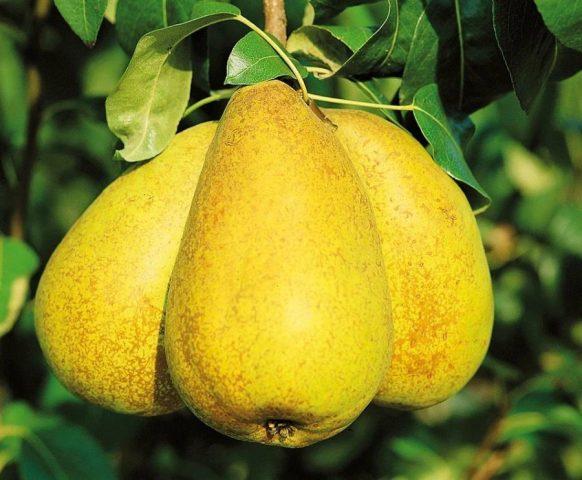
The winter hardiness index of the Aprelka pear is -40 °C
Lyra
The pear variety for the Ural region is characterized by high yield.It bears large fruits up to 240 g, the shape of the fruit is regular, slightly elongated with an expansion at the bottom, the color is yellow with reddish splashes. The pulp is creamy, sweet, with a slight pleasant sourness.

The Lyra variety ripens in the Urals at the end of September
The Lira variety is suitable for long-term storage. You can keep the fruits in a warm place until the New Year, and in the cellar or refrigerator until the beginning of March.
Perun
The zoned pear variety is suitable for breeding in Siberia and the Urals. It is resistant to fungi and bacterial diseases and tolerates frosts below -30 °C. It ripens in mid-October, but acquires its most pleasant taste only in January.
The fruits of the Perun variety reach 140 g in weight. The color of the fruit is yellow with a slight green tint; there may be reddish streaks on the sides. The pulp is sweet, fine-grained, with good density, white in color.

It is recommended to harvest the Perun variety about ten days before final ripening
Delicious varieties of pears for the Urals
The most prized varieties of pears for the Urals are juicy ones with a rich sweet taste. They are considered dessert and are well suited for both fresh consumption and heat treatment or preservation.
Zarechnaya
A medium-sized pear for the Urals begins to bear fruit from the fifth year of life. It produces abundant fruit and is not affected by scab and gall mite. The pears are bright golden in color, with a bright peach blush. The pulp of the variety is creamy, sweet in taste, with a slight refreshing sourness.
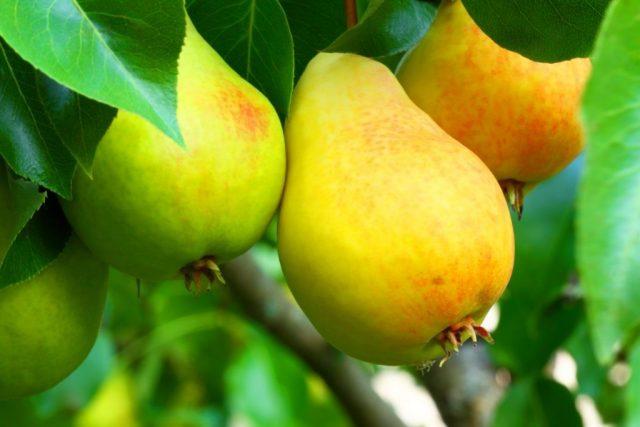
Zarechnaya pear harvest can be stored for up to a month
The fruits of the Zarechnaya pear are compact and have a standard elongated shape. The average weight is about 115 g.Ripe fruits emit a rich, pleasant aroma.
Severyanka
A frost-resistant pear variety for the southern Urals has a good ability to recover. In severe cold weather, it may freeze slightly, but this has practically no effect on fruiting indicators. The variety begins to produce harvests in the fifth year after planting; fruits ripen on the shoots in mid-August.
Severyanka pears are sweet and sour, with a light aroma. The skin is thin yellow-green, with a slight pinkish blush. The weight of the fruit averages about 85 g.

Severyanka pears should preferably be consumed within one and a half weeks after harvesting.
Penguin
A frost-resistant pear variety with rapid growth tolerates winter in the Urals and sudden spring cold snaps. Forms large fruits up to 125 g in weight, the skin of the fruit is yellow with a slight reddish tint. The pulp is dense, juicy, with a dessert-sweet taste.

The Penguin variety in the Urals ripens in August
Self-fertile pear varieties for the Urals
Self-fertile pear varieties are very popular among gardeners. Such trees do not necessarily require pollinators to be planted nearby and set fruit on their own.
Chizhevskaya
The summer pear for the Urals is characterized by high frost resistance. It does not have strict care requirements and grows easily in poor soils. It blooms no earlier than mid-May and usually does not suffer from return frosts in the region.
The harvest of this variety ripens in August. Ripe pears have a regular shape, greenish-yellow color and a sweetish taste. The weight usually reaches 150 g, they are distinguished by density and juiciness.

One Chizhevskaya pear can produce up to 60 kg of harvest during the season
Veles
The hardy variety bears large fruits up to 180 g. The shape of the fruit is wide, neat, and after ripening they acquire a beautiful yellow-green hue. On the sunny side there is usually an orange blush. The fruits are sweet and sour to taste and emit a nice light aroma.
Veles pears can be harvested from late August to early September. The fruits stick well to the branches and do not fall off. The harvest can be stored for up to two months in a cool place.
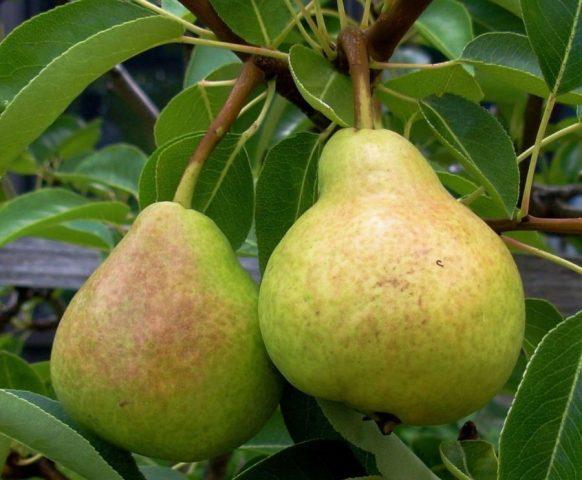
Veles pear can withstand frosts down to -25 °C and below with good insulation
Prominent
The late summer variety ripens in late August. Demonstrates consistently high productivity with abundant fruiting, sets large fruits up to 150 g in weight. The skin is dense, greenish with a golden tint, and may have a slight blush. The pulp is white, juicy, sweet in taste with sour notes.
The Vidnaya variety is optimally suited for the Urals, as it is not afraid of winter cold and return frosts. It enters the fruiting period early - in the fourth season after planting.

The fruits of the Vidnaya variety are stored for a short time - no more than a week at room temperature
Low-growing pear varieties for the Urals
In the Urals, short varieties of pears are most often planted. It is easier to care for such trees; in particular, there are no problems with insulating the plants along the crown for the winter.
Carmen
The pear grows to a maximum of 3 m above the ground and has a compact pyramidal crown. In mid-summer it bears large fruits up to 200 g of ideal regular shape. The variety has an interesting color - the skin is dark yellow, but almost completely covered with a burgundy blush. The taste of the pulp is sweet, pleasant, with a delicate aroma.

In one season, up to 30 kg of fruit can be removed from the Carmen pear
Decor
The dwarf pear for the Urals rises up to 2 m above the ground. The crown of the tree is narrow, the shoots grow vertically upward at an acute angle relative to the trunk. The variety is valued by gardeners because it is convenient to prune and cover for the winter.
Fruiting of the variety begins in mid-August. Quite large fruits weighing up to 250 g are formed on the shoots. The shape of the fruit is classic, without pronounced ribs, the color is uniform yellow without blush. The pulp is sweet and delicate in taste, juicy, and emits a bright aroma.
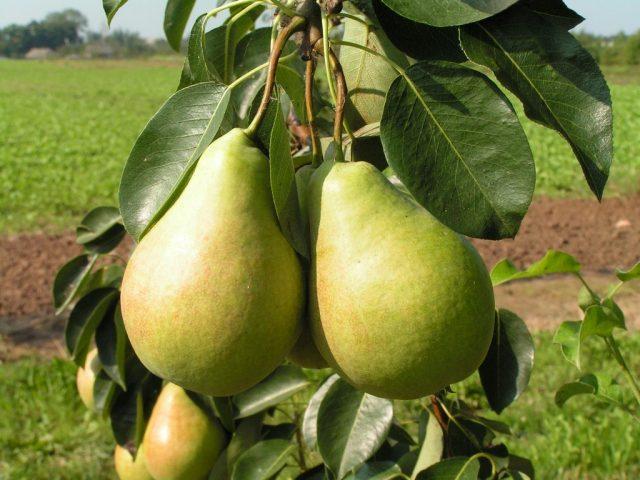
Decora begins to bear fruit in the Urals already in the third year of life.
Bogatyr
The variety, popular in the Urals, reaches only 2-3 m above the ground. It begins to bear fruit early; the first harvest from trees can be collected already 2-3 seasons after planting on the site. The fruits are weighty, large, up to 300 g, with a honey aroma and sweet pulp. You can harvest the shoots in early October.

Bogatyr is suitable for transportation because it does not deteriorate for a long time during storage
Columnar pear varieties for the Urals
Columnar pears are compact and do not require complex care. They do not need frequent intensive pruning; for the winter, trees can be covered along the crown with non-woven material.
Honey
The summer pear variety ripens towards the end of August. Bears light yellow fruits with orange spots on the sunny side. The fruits are large, some specimens reach 400 g. The fruit has a sweet taste and a rich aroma. The harvest can be stored for a long time - up to five months in the refrigerator or cellar.

Honey tree tolerates cold well and grows calmly in poor soil.
Sanremi
The columnar winter pear grows up to 2 m in the Urals. It produces large fruits up to 400 g, round in shape and uniformly yellow in color.The taste of the pulp is sweet, without sour notes or astringency. The variety is hardy, not afraid of frosts down to -35 °C with high-quality shelter, and rarely suffers from pests and fungal infections.

The Sanremi harvest ripens in early October
Sapphira
The columnar pear begins to bear fruit in the third year of life. Produces greenish elongated fruits with a slight pink blush. Their weight can reach 50-300 g, their taste is sweet with a pleasant sourness. Mass ripening occurs towards the end of September, and the harvest can be stored in a cool place until December.

Sapphira bears fruit consistently regardless of the weather
Conclusion
The best pear varieties for the Urals are represented by early and late varieties. When choosing, you should give preference to the hardiest plants with strong immunity.
Reviews of pear varieties for the Urals





